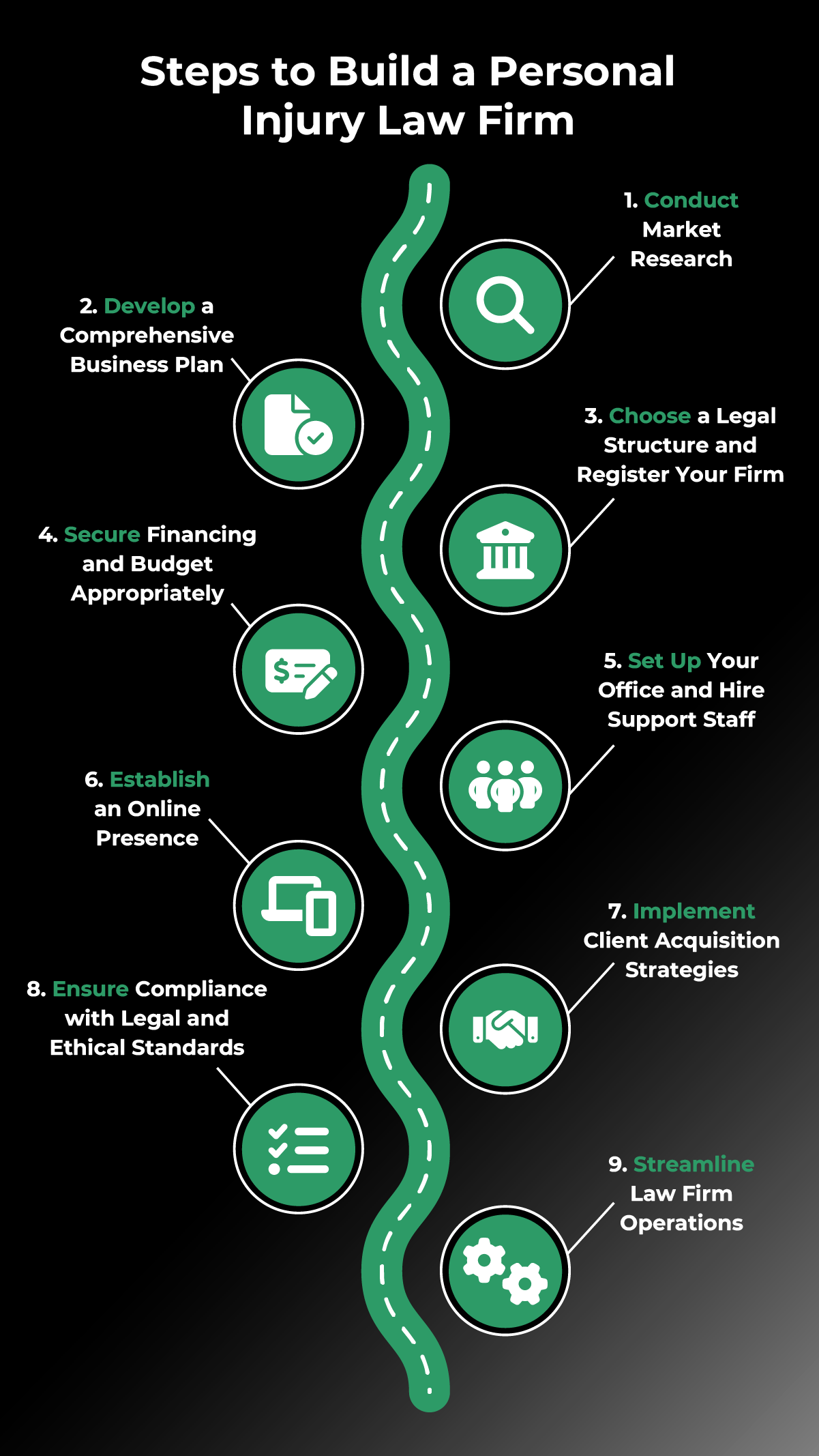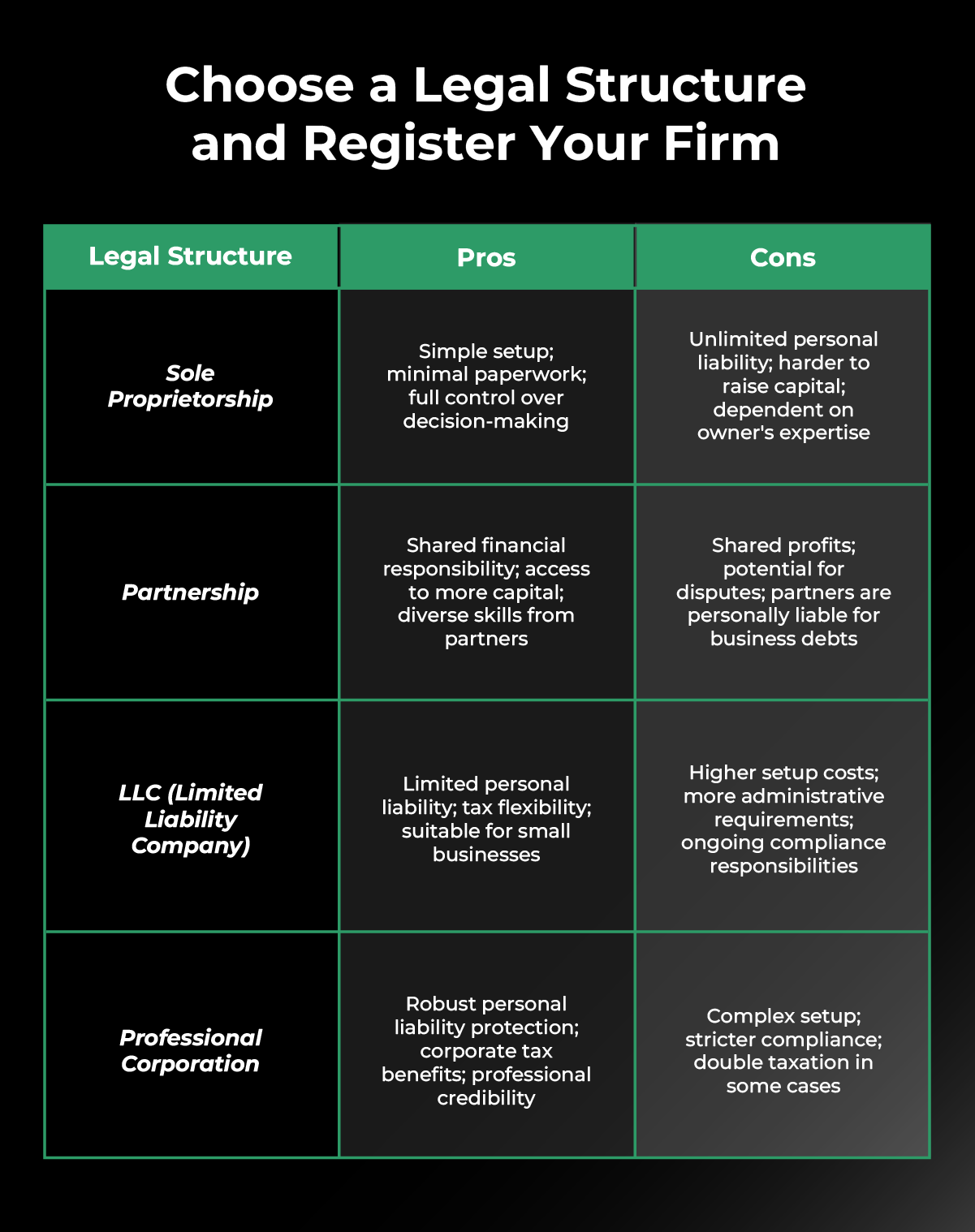How to Grow Your Law Firm in 2025: Strategies for Success
Discover effective strategies to grow your law firm in 2025. Boost clients, improve marketing, and stand out in a competitive legal market.
Learn how to start a successful personal injury law firm with strategic planning, market research, business plans, marketing strategies, and technology solutions.
Starting a personal injury law firm can be a rewarding endeavor for attorneys who want to make a meaningful impact. From representing individuals injured in motor vehicle accidents to advocating for victims harmed by defective products, a personal injury practice offers the chance to champion clients’ rights.
However, the process of launching a new law firm requires strategic planning and a thorough understanding of industry trends, common pitfalls, and best practices. This article walks you through how to start a personal injury law firm—covering everything from market research to business planning, marketing, and technology solutions.
The personal injury law sector has remained robust due to a consistent demand for legal representation in cases involving accidents, workplace injuries, and negligence. According to IBISWorld, the personal injury lawyers and attorneys market in the United States was valued at approximately $57.3 billion in 2024, reflecting a 0.4% increase from the previous year. Over the past five years, the industry has experienced a compound annual growth rate (CAGR) of 2%.
This steady demand is driven by factors such as population growth, rising healthcare costs, and an increasing public awareness of legal rights. Below are some of the most common reasons for demand growth for personal injury law:
As a result, these positive market indicators suggest that there is an ongoing need for legal services in this niche.
While there are a plethora of benefits to starting a personal injury law firm, below are a few of the most common challenges for attorneys looking to start a personal injury firm.
Personal injury is one of the most crowded practice areas. Many lawyers are attracted by the potential for high-value settlements, so standing out among established competitors is crucial. Differentiation can involve focusing on a niche—like bicycle accidents or medical malpractice—to capture a specific market segment.
Personal injury cases typically work on a contingency fee basis, which means attorneys only get paid if they secure a settlement or win a judgment. This structure can lead to significant cash flow challenges. Litigation costs (e.g., expert witnesses, filing fees, and discovery-related expenses) often arise well before any settlement is reached.
You may face limited mentorship opportunities if you branch out on your own. However, becoming a successful personal injury lawyer is much more streamlined when you engage with experienced attorneys who can be invaluable for guidance on legal strategy, firm management, and marketing tactics. Proactively seeking mentorship within bar associations or networking groups can help close this gap.
Starting a personal injury law firm involves strategic planning and careful execution to ensure long-term success. By following these essential steps, you can build a strong foundation for your practice, effectively attract clients, and maintain compliance with legal and ethical standards.

Comprehensive research is the foundation of any successful personal injury law firm. Begin by examining local accident data, population growth, and relevant demographic information to confirm demand for personal injury legal services in your area. Next, study local competitors—what types of personal injury cases they handle and how they market their services—to pinpoint opportunities for your firm to stand out. If your region’s legal market is crowded, consider specializing in a niche such as traumatic brain injuries, premises liability, or wrongful death. This approach helps you carve out a unique space and highlight your expertise.
A structured personal injury law firm business plan offers a clear roadmap for serving clients, managing growth, and maintaining profitability. Start by definingyour mission—such as providing compassionate advocacy for individuals injured through negligence—and outline the specific practice areas you intend to cover. Then, calculate projected expenses (e.g., office rent, malpractice insurance, marketing) and identify how many cases you need to reach your financial objectives. Personal injury cases can take months or even years to resolve, so plan for fluctuations in cash flow. This blueprint helps you anticipate challenges and track the firm’s progress over time.
Your legal structure affects liability, taxation, and firm management. While sole proprietorships and partnerships are simpler, they also expose personal assets to risk. Limited liability companies (LLCs) and professional corporations offer more robust protection—though they typically involve more administrative work. Once you settle on a structure, register your business with the appropriate state agencies and obtain any required licenses. If you’re uncertain about the best option, consult an experienced business attorney or a certified public accountant (CPA) for guidance.

Opening a personal injury law firm can entail significant costs. Beyond standard expenses such as office rent and technology, you’ll need to account for staff salaries and operational tools like case management software. Because personal injury fees often depend on settlements, plan for delayed revenue by establishing a reserve fund. This approach helps you cover everyday expenses while waiting for cases to resolve. Consider all available funding sources—personal savings, traditional bank loans, or private investors—to ensure a secure financial foundation.
A welcoming, well-organized office helps set a professional tone for potential clients. Look for a location with ample parking, easy accessibility, and room to expand as your firm grows. Equip your office with secure document management systems, high-speed internet, and updated computer hardware. Hiring the right team is equally critical—receptionists, paralegals, and legal assistants can coordinate administrative tasks and streamline case preparation. This support allows you to dedicate more time to key responsibilities such as legal research, client communication, and courtroom advocacy.
Most people seeking legal help begin their search online, making a polished digital presence vital. Develop a user-friendly website that highlights your services, features attorney bios, and clearly outlines how you can assist injury victims. Incorporate search engine optimization (SEO) strategies so prospective clients can find you when searching for phrases like “personal injury lawyer” or “car accident attorney.” Additionally, Social media platforms—like LinkedIn or Facebook—can further expand your reach, allowing you to connect with local businesses and prospective clients. Furthermore, encourage positive reviews on platforms such as Google, and address any concerns swiftly to maintain a strong reputation.
A focused marketing strategy ensures a steady flow of personal injury leads. Consider online advertising to target individuals actively seeking representation, and produce educational content—such as blogs or videos—to demonstrate your firm’s knowledge and credibility. Building referral partnerships is also beneficial. Collaborate with medical providers or other attorneys who don’t practice personal injury law, so they can refer potential clients to you. Additionally, community involvement—like sponsoring local events or joining networking groups—helps build name recognition and fosters trust among residents.
Compliance with all state, local, and American Bar Association (ABA) guidelines is essential. Keep up to date with advertising and solicitation rules, fee agreement requirements, and the ethical standards governing your jurisdiction. Also, maintain professional liability insurance—often referred to as malpractice insurance—to protect your firm from potential claims. Ethical conduct and thorough compliance not only build credibility but also safeguard your firm against costly sanctions or legal complications.
Efficiency is especially important in personal injury practices, where you may manage multiple cases simultaneously. Establish standardized intake processes, follow-up reminders, and templates for key documents. Also consider leveraging a dedicated platform designed for personal injury attorneys to automate workflows, track case details, and maintain clear communication with clients. By reducing manual tasks, your team can focus on case strategy, negotiations, and client service—ultimately strengthening your firm’s reputation.
Building a successful personal injury law firm requires the right mix of people, processes, and technology. Below are essential tools that can help you stay organized, serve clients effectively, and keep your practice running smoothly.
A centralized personal injury law firm management software is indispensable. It helps coordinate day-to-day tasks—such as tracking client information and deadlines—while providing a clear overview of case progress. By automating routine activities, you can free up more time for client communication, negotiation strategies, and trial preparation.
Case management tools make it easier to store and retrieve critical details like evidence, witness information, and case timelines. They also streamline task delegation so your team stays aligned on the next steps. This organized approach helps ensure no vital detail falls through the cracks.
Implementing a secure document management system reduces the risk of lost files and enables instant access to key paperwork. Digitally organizing pleadings, client records, and discovery documents can also simplify team collaboration—especially when multiple attorneys or paralegals work on the same case.
A CRM platform is vital for nurturing potential leads and maintaining client relationships. By capturing contact details and interactions in one place, you can follow up effectively and foster a positive experience for new and existing clients. This system also helps you personalize communication and build long-term trust.
Workflow automation tools handle repetitive tasks—such as sending appointment reminders, generating status updates, or assigning next steps—so your team can focus on more complex work. This boosts productivity and ensures every case progresses without unnecessary delays.
E-signature tools allow clients to sign documents from anywhere, reducing the need for in-person meetings or mailing paperwork. This convenience improves the client experience and accelerates processes like retainer agreements, settlement releases, and other legal forms.
Missing a critical deadline can be disastrous in a personal injury case. Statute alert features help you stay on top of filing deadlines, limitation periods, and important court dates—drastically lowering the risk of errors that could harm client outcomes.
Settlement management tools help track offers, calculate potential payouts, and manage negotiation communications. Keeping all the details organized in one place makes it easier to evaluate settlement options and maintain a clear record of discussions and final agreements.
A secure client portal offers 24/7 access to case updates, upcoming deadlines, and relevant documents. This reduces the volume of inbound inquiries—freeing up your team’s time while keeping clients informed and satisfied with the progress of their cases.
Custom reporting features allow you to analyze important metrics—such as average case duration or settlement outcomes. By reviewing these data points, you can identify trends and make informed decisions that enhance your law firm’s efficiency and profitability.
Accurate expense tracking ensures you stay on top of costs—from filing fees to expert witness invoices—so you can manage budgets effectively and maintain a clear picture of your firm’s financial health. Detailed expense records thats captured from expense tracking can also helpaccount for all case-related expenditures when negotiating fees or settlements.
Well-maintained accounting software keeps your financials accurate and compliant. Timely invoicing, transparent trust accounting, and seamless reconciliation help you avoid ethical pitfalls and reduce the risk of audits or financial missteps.
Protecting sensitive client information is non-negotiable. Secure systems with robust encryption, multi-factor authentication, and regular security updates minimize the risk of breaches and maintain client trust.
CASEpeer is designed to support personal injury attorneys as they start a new law firm, including everything from intake to settlement. With robust capabilities for case management, settlement tracking, and document sharing, it is especially useful for lawyers seeking a comprehensive solution. CASEpeer also offers:
Whether you’re just starting a personal injury law firm or looking to scale an existing one, these tools can help you operate more efficiently and provide better service to your clients.
Book a demo and start streamlining all your personal injury practice activities.
Discover effective strategies to grow your law firm in 2025. Boost clients, improve marketing, and stand out in a competitive legal market.
Discover how lawyers can build a powerful brand to stand out, gain trust, and attract the right clients with these proven strategies.
Discover these email marketing strategies tailored for lawyers. Drive client engagement, grow your practice, and achieve measurable success.